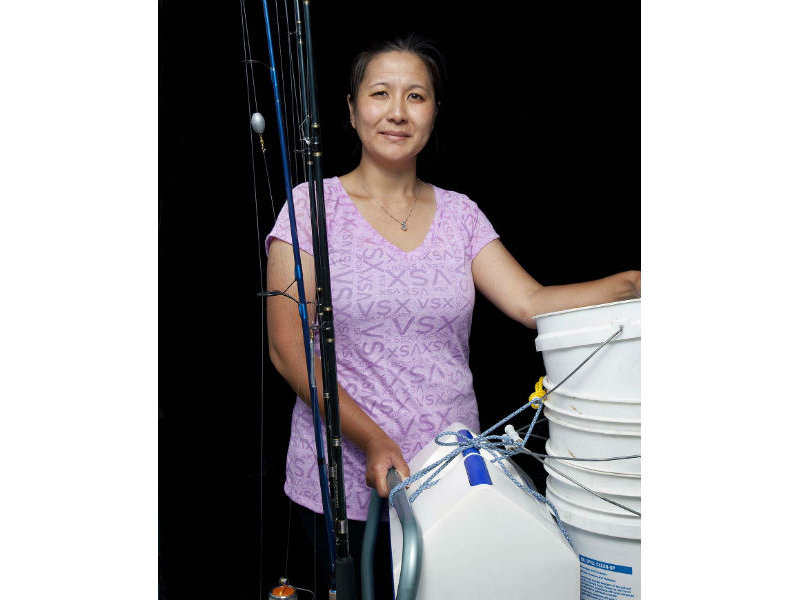Though the exhibition was a small one, Milwaukee photographer Kevin Miyazaki's "Perimeter" show at the Haggerty Museum was one of the highlights of the local arts scene in 2013.
To create the works, Miyazaki traveled 1,800 miles around Lake Michigan photographing the lake itself, but also the people linked to it in Wisconsin, Michigan, Illinois and Indiana. The project was commissioned by Marquette University, on whose campus the Haggerty is located.
Now, the larger work is the subject of "Perimeter: A Contemporary Portrait of Lake Michigan," published in hardcover by Wisconsin Historical Society Press. It's hard to choose which are more striking: Miyazaki's lakescapes, which showcase the many faces and colors of this huge inland sea, or the faces of the faces of all ages, colors and shapes that use the lake for work and play, from fishermen to surfers, scientists to residents, boaters and Native American water rights advocates.
There are 140 images in the book, which Miyazaki will highlight in a special book reception, Wednesday, Sept. 17 at the Haggerty Museum of Art at 6 p.m. We caught up with Miyazaki to ask him about the inspiration for and the perspiration of creating this unmatched exploration of Lake Michigan and its diverse users.
OnMilwaukee.com: What drew you to the lake as inspiration? Has it always had a pull on you?
Kevin Miyazaki: I think for Milwaukeeans the lake serves as our compass, in terms of navigation and also for our sense of place. The lake is always there, to orient and ground us.
I’m not sure if it had more of a pull on me than the average person living here -- I do have fond childhood memories of my dad bringing home salmon from fishing trips on the lake, and I spent many hours at Bradford Beach one summer during high school.
Of course, I have a new, deeper appreciation.
OMC: How did that inspiration develop into the actual project? How did you conceive of the plan that guided you?
KM: I was approached by the Haggerty Museum of Art at Marquette with the request to create new work relating to the Great Lakes and fresh water. The project would be funded, open to my interpretation and result in an exhibition at the museum.
I had become interested in making typological portraits -- photographs of individuals against a plain, black background. It began when I photographed protesters at the state capital in 2011.
This type of photographic approach serves to celebrate the individual and the result can be compelling, especially when viewed as a series or group.
So I proposed to make a new set of portraits, of people who live, work and recreate around Lake Michigan. I constructed a portable version of the lighting setup I had been using, and set out on a 13-day, 1,800-mile drive around the lake.
OMC: What did you learn on your circumnavigation of Lake Michigan? Did anything especially surprise you?
KM: The focus of the project were the portraits, but I also photographed the water as I went. I made simple photographs of the lake and sky, which served as a record of the trip. I knew that this would be a diverse set of pictures, in terms of light and time of day. But I was surprised by the diversity of light, color, and mood of the lake. The water pictures became more important to me as I went along, and ultimately became part of the exhibition and book.
And this is not something that surprised me, but rather reinforced what I knew to be true: Midwesterners are kind. I met hundreds of people on this trip, asking if I could make their picture, asking directions, asking for good places to eat. There was so much goodwill and positive energy encountered along the way.
OMC: The lake surely means different things to different people, did you find that geography affects that meaning?
KM: I certainly found a diverse set of people -- those that work on the lake, spend their weekends there, and live in close proximity. I don’t think geography played a part in how those people think about it, in their love for it. I think that was quite similar wherever I was.
An exception might be where industry is so dominant. I photographed steel workers in Indiana, and also made pictures of beach goers within eyesight of a huge industrial facility there. What the lake means to people in Whiting, Ind., may be a bit more complex than in other places.
OMC: Did you find yourself disoriented when the lake was no longer to the east? It's pretty
strange watching the sun set over Lake Michigan, isn't it?
KM: The trip was like taking one giant left turn. I have to say, the western coast of Michigan is gorgeous and the beaches on the Wisconsin side can’t hold a candle to them, unfortunately.
OMC: Will there be future exhibitions of the work from "Perimeter"?
KM: There were 98 photographs in the Haggerty show, individual pictures that were tiled together on the walls. So the work can be shown in the future in modular configurations, depending on the venues. I’m hoping the pictures can be seen in places large and small, featuring subjects from the project close to where they live.
Born in Brooklyn, N.Y., where he lived until he was 17, Bobby received his BA-Mass Communications from UWM in 1989 and has lived in Walker's Point, Bay View, Enderis Park, South Milwaukee and on the East Side.
He has published three non-fiction books in Italy – including one about an event in Milwaukee history, which was published in the U.S. in autumn 2010. Four more books, all about Milwaukee, have been published by The History Press.
With his most recent band, The Yell Leaders, Bobby released four LPs and had a songs featured in episodes of TV's "Party of Five" and "Dawson's Creek," and films in Japan, South America and the U.S. The Yell Leaders were named the best unsigned band in their region by VH-1 as part of its Rock Across America 1998 Tour. Most recently, the band contributed tracks to a UK vinyl/CD tribute to the Redskins and collaborated on a track with Italian novelist Enrico Remmert.
He's produced three installments of the "OMCD" series of local music compilations for OnMilwaukee.com and in 2007 produced a CD of Italian music and poetry.
In 2005, he was awarded the City of Asti's (Italy) Journalism Prize for his work focusing on that area. He has also won awards from the Milwaukee Press Club.
He has be heard on 88Nine Radio Milwaukee talking about his "Urban Spelunking" series of stories, in that station's most popular podcast.







